If you’re familiar with the darkly funny animated series “South Park,” you know there’s nothing that tubby 9-year-old Eric Cartman hates more than hippies. In the 2005 episode “Die Hippie, Die,” he gallantly waddles from house to house with an exterminator tank, hell-bent on ridding the neighborhood of the bad-smelling, peace-preaching stoners. Well, in my small hometown in the late 1960s, we had but one authentic hippie, and we intended to keep him.
By the time the Age of Aquarius hit Pennsyltucky, it was already the Age of Libra. For years we stared at our cabinet TVs with envy at the scenes of flower-children burning draft cards in Chicago, marching for peace in D.C., and dancing in a hallucinogenic stupor in Golden Gate Park. Just when we’d nearly given up hope that we’d ever be hip, God answered our prayers and gave us something to break the monotony of our boring, bourgeois lives: a bearded, long-haired, blurry-eyed, sandaled dude whom the town elders affectionately called “The Dirty Hippie.” So touched was he by this moniker that he actually painted the nom de freak on the side of his psychedelically embellished pickup truck. You bet your bippy! What a treat to see him whiz by — “Sunshine of your Love” and fragrant smoke wafting from his windows — as we walked home from school. “Hey look! It’s the Dirty Hippie!” we’d cry out as we waved. I have no idea whether our token tokin’ rebel embraced the make-love-not-war ideology of the times, but he looked like he stepped right out of central casting for “Easy Rider.” And that was good enough for us. We didn’t want any trouble-making pinko types, anyway. We weren’t ready for our small hamlet to become infested with the city-bred rodent variety of hippie — like those personified by David Peel.
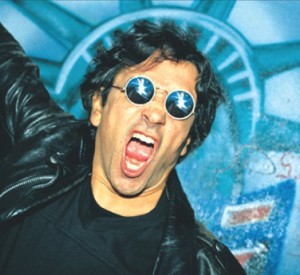 I was 12 years old, watching The David Frost show on TV after school, when I discovered Mr. Peel. As the veddy, veddy British talk show host introduced a musical number, I was delighted to see John Lennon on stage with an assortment of musicians I didn’t recognize. But why was John (and the ubiquitous Yoko) standing in the back, banging away on a homemade stringed instrument, and not in the spotlight? Who was the wire-haired dude with Lennonesque granny glasses shouting into the microphone? And why was he singing funny lyrics to Merle Haggard’s “Okie from Muskogee” song? This was too much!
I was 12 years old, watching The David Frost show on TV after school, when I discovered Mr. Peel. As the veddy, veddy British talk show host introduced a musical number, I was delighted to see John Lennon on stage with an assortment of musicians I didn’t recognize. But why was John (and the ubiquitous Yoko) standing in the back, banging away on a homemade stringed instrument, and not in the spotlight? Who was the wire-haired dude with Lennonesque granny glasses shouting into the microphone? And why was he singing funny lyrics to Merle Haggard’s “Okie from Muskogee” song? This was too much!
I’m proud to be a New York City hippie / I’m proud of dirty feet and dirty hair.
I’m proud of living with the cock-a-roaches / I’m proud of living in a garbage can.
We want to warn you squares and all you rednecks: If you hate the hippies from New York,
We’ll unify the hippies from the country /We’ll fight until the South becomes the North.
Wow! The high literature of Mad magazine set to music! This truly appealed to my 7th grade brain. I would never forget this TV performance, or the name of the singer, David Peel. And I vowed that one day I would learn all about this dirty hippie.
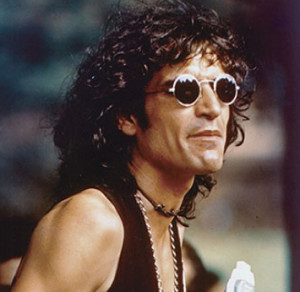 Born David Michael Rosario in Brooklyn, Peel was, and remains, a singer, songwriter, musician, activist, street performer, and self-described radical. In 1968, he and his band, The Lower East Side, landed a contract with Elektra Records and subsequently released two albums that were groundbreaking in theme and content: “Have a Marijuana” and “The American Revolution.” Kudos to Elektra for releasing LPs with song titles like “I’ve Got Some Grass,” “Hey Mr. Draft Board,” “I Want To Get High,” “Show Me the Way to Get Stoned,” and the police-hating “Oink, Oink.” Smells like early punk rock to me.
Born David Michael Rosario in Brooklyn, Peel was, and remains, a singer, songwriter, musician, activist, street performer, and self-described radical. In 1968, he and his band, The Lower East Side, landed a contract with Elektra Records and subsequently released two albums that were groundbreaking in theme and content: “Have a Marijuana” and “The American Revolution.” Kudos to Elektra for releasing LPs with song titles like “I’ve Got Some Grass,” “Hey Mr. Draft Board,” “I Want To Get High,” “Show Me the Way to Get Stoned,” and the police-hating “Oink, Oink.” Smells like early punk rock to me.
Peel has been described as the Woodie Guthrie of Yippie politics. He prided himself on being a street musician – of the people, by the people, for the people – and gained most of his notoriety shouting out his satirical ditties in Washington Square Park in Greenwich Village. Still, outside of New York counter-culture society, Peel remained very much an underground novelty. Until another radically minded singer-songwriter happened upon his act.
One day in 1971, two newly-minted New Yorkers, John and Yoko Ono Lennon, wandered into Washington Square Park with their friend, rock journalist and producer Howard Smith. There, John saw Peel for the first time. The street singer shouted out something like, “Why do you have to pay to see stars?” John thought that Peel was referring to him, and his interest was piqued. It wouldn’t be long before Yippie leaders Jerry Rubin and Abbie Hoffman would lead John back to the park and introduce him to Peel. They hit it off immediately. “He’s such a great guy,” said Lennon in 1972. “We loved his music and his spirit and everything — his whole philosophy of the street.”
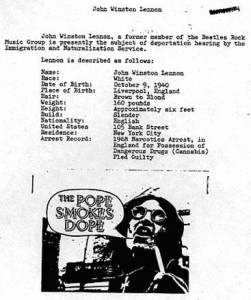 The next thing you know, John signs Peel to The Beatles’ Apple Records (against the objections of some of his former bandmates) and is producing his infamous LP, “The Pope Smokes Dope.” Its title song, along with such tunes as “F is Not a Dirty Word,” “I’m Gonna Start Another Riot,” and “The Birth Control Blues” ensured that the LP would be banned in nearly every country except the United States and Canada. Now, with John’s blessing and a banned record, Peel not only was the new darling of the anti-establishment, he had a free pass to enter the living rooms of Middle America by way of the David Frost show. With his round, wire-rimmed sunglasses and prominent nose, he looked so much like John that the FBI mistakenly used his photo in a fact sheet they produced for Nixon’s “deport Lennon” campaign.
The next thing you know, John signs Peel to The Beatles’ Apple Records (against the objections of some of his former bandmates) and is producing his infamous LP, “The Pope Smokes Dope.” Its title song, along with such tunes as “F is Not a Dirty Word,” “I’m Gonna Start Another Riot,” and “The Birth Control Blues” ensured that the LP would be banned in nearly every country except the United States and Canada. Now, with John’s blessing and a banned record, Peel not only was the new darling of the anti-establishment, he had a free pass to enter the living rooms of Middle America by way of the David Frost show. With his round, wire-rimmed sunglasses and prominent nose, he looked so much like John that the FBI mistakenly used his photo in a fact sheet they produced for Nixon’s “deport Lennon” campaign.
While John went on to produce Peel’s single, “America,” for the soundtrack of the film “Please Stand By,” Apple records did not renew his contract. Wary of censorship battles with established record labels, he formed an independent company, Orange Records, to release his own material and that of other artists. His 1976 LP, “An Evening With David Peel,” has been praised for perfectly capturing the sound and spirit of the chaotic early ’70s underground movement. He’s been recording, without fanfare, for decades. You can download his songs from iTunes and Amazon.com.
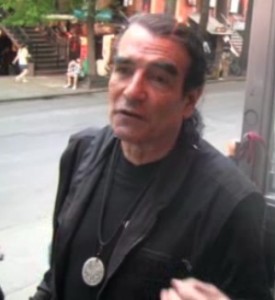
Thanks to Lennon’s association, Peel went from playing parks to stadiums, alongside such artists as Rod Stewart, B.B. King, Alice Cooper, Dr. John, Frank Zappa, Iggy Pop, MC5, John Lee Hooker, Roger McGuinn, Richie Havens, Odetta, Arlo Guthrie, Stevie Wonder, Joan Baez, Cypress Hill, and The Ramones.
But despite his high profile gigs, Peel’s always felt most comfortable on the streets of New York, performing gratis for everyday people. At age 70, he’s still a bachelor, sans children, and lives in a rent-controlled apartment on Avenue B in the East Village. He gets by on songwriting royalties, sales of old records, and the occasional gig. He’s made a comeback in recent years, writing songs for the Occupy Wall Street movement and singing and strumming his way into the hearts of a new generation of rabble rousers. He told a New York Times reporter in 2012 that he plans to continue to sing on the streets and in the parks “until the day I drop dead and go to rock ’n’ roll heaven.”
Let’s just hope there’s plenty of weed behind those pearly gates — if the popes haven’t smoked it all up, that is.
UPDATE: I just leaned that Mr. Peel died on April 6, 2017, following a heart attack. Wherever you are, David, keep stirring the pot!
Here’s David Peel and The Lower East Side, along with John, Yoko, and Jerry Rubin, performing “Hippie from New York City” on David Frost’s show in 1972. It’s a biting parody of Merle Haggard’s “Okie from Muskogee.”
Here are audio clips of John, discussing David’s appeal: “People say, ‘Oh, you know Peel – he can’t sing, or he can’t really play and that,’ but he writes beautiful songs, you know, and even sort of as simple as his basic chord structures are, supposedly. Well you know, Picasso spent 40 years trying to get as simple as that.”
This South Park clip is from the episode called “Die Hippie, Die,” which shows Eric Cartman trying to rid the town of hippies.
© Dana Spiardi, March 6, 2013
]]>
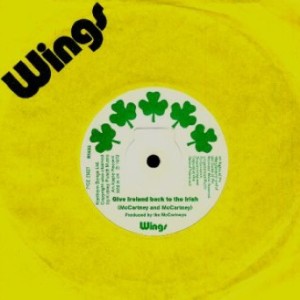 Paul’s record company EMI reluctantly agreed to let him and his band Wings record and release the protest song, but warned it would be banned. Which, of course, it was — by the BBC, Radio Luxembourg and the U.K.’s Independent Television Authority. But despite its lack of airplay it managed to chart – reaching the #1 spot in Ireland and Spain, #16 in the U.K., and #21 in the U.S. Like John and Yoko, whose “Two Virgins” album was banned for full frontal nudity on its cover, Paul now had his own censored piece of work, thus qualifying him for membership in the rock-n-roll rabble-rousers society (at least for a short time).
Paul’s record company EMI reluctantly agreed to let him and his band Wings record and release the protest song, but warned it would be banned. Which, of course, it was — by the BBC, Radio Luxembourg and the U.K.’s Independent Television Authority. But despite its lack of airplay it managed to chart – reaching the #1 spot in Ireland and Spain, #16 in the U.K., and #21 in the U.S. Like John and Yoko, whose “Two Virgins” album was banned for full frontal nudity on its cover, Paul now had his own censored piece of work, thus qualifying him for membership in the rock-n-roll rabble-rousers society (at least for a short time).
Most people aren’t aware that John had also recorded two songs in response to Britain’s brutal treatment of Ireland: “Sunday Bloody Sunday” and “The Luck of the Irish,” both featured on his June 1972 LP “Some Time in New York City.”
John said he was inspired to write “The Luck of the Irish” after taking part in a 1971 London protest march in support of Ireland. Said John, “I’m a quarter Irish or half Irish or something, and long, long before the trouble started, I told Yoko that’s where we’re going to retire, and I took her to Ireland. We went around Ireland a bit and we stayed in Ireland and we had a sort of second honeymoon there. So I was completely involved in Ireland.”
Many critics lauded John’s empathetic song supporting the Emerald Isle – in the ‘Pool they told us the story / how the English divided the land / of the pain and the death and the glory / and the poets of old Ireland – but bemoaned Yoko’s contribution to the lyrics, which included mentions of shamrocks, rainbows and leprechauns, and a hope for the “world [to] be one big Blarney stone.”
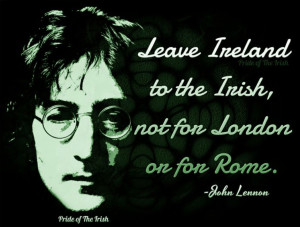 In response to Bloody Sunday, John participated in a protest outside the New York office of Britain’s national airline, BOAC. Soon after, he wrote “Sunday Bloody Sunday.” Commenting on his motivation to pen the song, he said: “Most other people express themselves by shouting or playing football at the weekend. But me, here I am in New York and I hear about the 13 [sic] people shot dead in Ireland, and I react immediately. And being what I am, I react in four-to-the-bar with a guitar break in the middle.”
In response to Bloody Sunday, John participated in a protest outside the New York office of Britain’s national airline, BOAC. Soon after, he wrote “Sunday Bloody Sunday.” Commenting on his motivation to pen the song, he said: “Most other people express themselves by shouting or playing football at the weekend. But me, here I am in New York and I hear about the 13 [sic] people shot dead in Ireland, and I react immediately. And being what I am, I react in four-to-the-bar with a guitar break in the middle.”
Interestingly, John recorded his song during the same month that Paul recorded “Give Ireland Back to the Irish.” But Paul beat John to the punch, releasing his single four months before Lennon’s song appeared on his “Some Time in New York City” album. The two were still in a period of backbiting and competition following the Beatles’ 1970 breakup, so John no doubt got his Irish up over Paul’s single, which was more timely and garnered much attention.
John’s original family surname was O’Lennain, the Gaelic word for love. But unlike most people who boast of even the most minuscule amount of Irish blood flowing through their veins, John rarely made a great deal of fanfare about his roots.
For the record, Paul is three-quarters Irish and George Harrison was one-quarter Irish. Poor Ringo hasn’t a drop of Irish blood, but we love him all the same.
Here’s John’s “Sunday Bloody Sunday”:
And “The Luck of the Irish,” minus Yoko’s singing:
And Paul’s “Give Ireland Back to the Irish”:
© Dana Spiardi, March 17, 2013
]]>
to measure record sales.
No song’s the winner,
no song ever fails.
Imagine all releases
treasured equally….
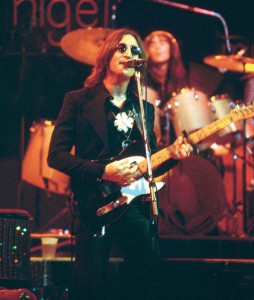 Imagine the most defining song of John Lennon’s career NOT reaching the number one spot on the Billboard charts when it was released in October 1971. I wonder if you can. Surprisingly, John’s iconic peace anthem “Imagine” actually peaked at number three, which just goes to prove that chart position does not a legendary song make. John’s only solo career single to hit the number one spot during his lifetime was “Whatever Gets You Through the Night,” which topped the U.S. charts in November 1974.
Imagine the most defining song of John Lennon’s career NOT reaching the number one spot on the Billboard charts when it was released in October 1971. I wonder if you can. Surprisingly, John’s iconic peace anthem “Imagine” actually peaked at number three, which just goes to prove that chart position does not a legendary song make. John’s only solo career single to hit the number one spot during his lifetime was “Whatever Gets You Through the Night,” which topped the U.S. charts in November 1974.
As was his method, media junkie John often copped song titles and ideas from tabloids and boob tube babble. One late night, while channel surfing in his New York City apartment, he stumbled upon a program featuring the black evangelist Reverend Ike, who said unto the TV audience: “Let me tell you guys, it doesn’t matter, it’s whatever gets you through the night.” Bingo. The rest came naturally.
In the summer of 1974, John called on his friends – all top session players of the day – to seal the song on vinyl. They included guitarist Jesse Ed Davis and drummer Jim Keltner. John’s pal from the Beatles’ early Hamburg days, Klaus Voormann, played bass, and his British brother-in-therapy Elton John provided backing vocals and piano. But it’s the song’s blast of sax, provided by Texan shit-kicker Bobby Keys, that gave the tune its rollicking signature sound.
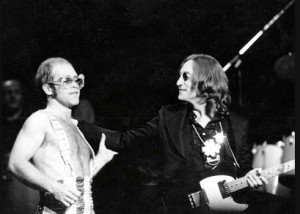 Recorded for the “Walls and Bridges” LP, Lennon had little faith that the song would make an impact as a single. But Elton felt otherwise. He made a wager: if the song hit number one, John would have to promise to perform at Elton’s Thanksgiving concert at Madison Square Garden on November 28, 1974. On November 10, the song rocketed to number one in the U.S., and John made good on his promise. To the audience’s great surprise, a very nervous former Beatle took the stage with Elton to sing “Whatever Gets You Through the Night,” “Lucy in the Sky with Diamonds,” and “I Saw Her Standing There.”
Recorded for the “Walls and Bridges” LP, Lennon had little faith that the song would make an impact as a single. But Elton felt otherwise. He made a wager: if the song hit number one, John would have to promise to perform at Elton’s Thanksgiving concert at Madison Square Garden on November 28, 1974. On November 10, the song rocketed to number one in the U.S., and John made good on his promise. To the audience’s great surprise, a very nervous former Beatle took the stage with Elton to sing “Whatever Gets You Through the Night,” “Lucy in the Sky with Diamonds,” and “I Saw Her Standing There.”
Who would have ever imagined that it would be John’s final concert performance?
Out the blue or out of sight,
S’alright, John. S’alright.
Watch this fabulous video of the song. It’s comprised of animations of John’s whimsical drawings.
By Dana Spiardi, Oct 9, 2014
]]>Right on, Jules. Even though I shed a tear each and every December 8th – the date of John’s murder in 1980 – this year I’d like to present an upbeat memorial to the man whose music changed my life. How about a little story about his influence on the city of Prague, the capital of the Czech Republic, where the Lennon Wall – Lennonova Zeď – stands as a symbol of freedom.
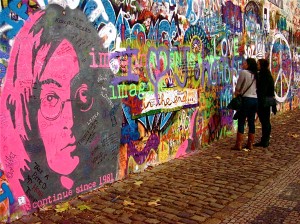 John was a voice of peace all over the world – even in the Communist-controlled countries of the former Soviet Union. The Commies tried their best to halt the influx of Western pop culture and fashion, but no Iron Curtain or Berlin Wall could keep out the Beatles. All the kids knew of them. And if you had black market connections, you could get your hands on one or two of their records — or at least a bootleg made from smuggled-in originals.
John was a voice of peace all over the world – even in the Communist-controlled countries of the former Soviet Union. The Commies tried their best to halt the influx of Western pop culture and fashion, but no Iron Curtain or Berlin Wall could keep out the Beatles. All the kids knew of them. And if you had black market connections, you could get your hands on one or two of their records — or at least a bootleg made from smuggled-in originals.
Enterprising music lovers routinely duplicated records using a device known as a roentgenizdat to press sound grooves onto the acetates of discarded x-ray plates. Imagine placing a film of Uncle Vladimir’s spleen on the turntable and rocking to “Abbey Road.”
The news of John Lennon’s murder in December 1980 sent shock waves around the world. In Prague, young people paid their respects by establishing an “unofficial” memorial to the fallen Beatle. They singled out a large wall at Grand Priory Square, and began covering it with beautiful graffiti images of John and his lyrics. The more rebellious of the lot – inspired by his message of “Power to the People” – also used the wall as a canvas on which to scrawl their grievances, particularly against Gustáv Husák, who ruled the country (then known as Czechoslovakia) – from 1969 through 1991.
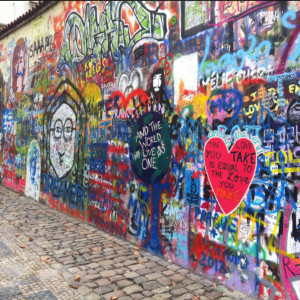 Husák succeeded President Alexander Dubček, whose liberal policies brought about the famous Prague Spring of 1968 — a period of relative freedom that effectively ended when Moscow rolled its tanks into the city’s Wenceslas Square as a clampdown on any burgeoning democracy. With Dubček soon banished, Husák reversed his short-lived policies and purged the country’s Communist Party of all its liberal members. The Czechs’ brief taste of freedom was gone.
Husák succeeded President Alexander Dubček, whose liberal policies brought about the famous Prague Spring of 1968 — a period of relative freedom that effectively ended when Moscow rolled its tanks into the city’s Wenceslas Square as a clampdown on any burgeoning democracy. With Dubček soon banished, Husák reversed his short-lived policies and purged the country’s Communist Party of all its liberal members. The Czechs’ brief taste of freedom was gone.
Flash forward 20 years: young men and women were increasingly aggravated by Husák’s growing conservatism. In the fall of 1988 they took to the Lennon Wall, airing their complaints in the form of anti-government graffiti. This and other acts of protest led to a huge clash between the police and hundreds of students on the city’s treasured Charles Bridge. The protestors called their activist ideology “Lennonism.” Czech authorities denounced the rabble rousers as crackpots, alcoholics, and proponents of Western capitalism. That episode was one of several that gave way to the Velvet Revolution, which culminated in the end of communist rule in November 1989.
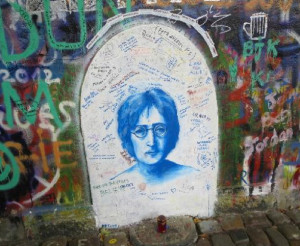 But despite its role in socio-political discourse, the wall never lost its original purpose: as a memorial to John’s life, music and messages. Czech authorities occasionally painted over the images, hoping to end the graffiti. But their efforts were useless. By the next day it was filled up again with Lennonisms. I had a chance to see what is perhaps the most powerful and famous graffiti portrait of John (the photo in the header above) when I first discovered the wall in 1991. Today, the memorial is a big tourist attraction – one that wasn’t listed in any of the city guides when I first set foot there.
But despite its role in socio-political discourse, the wall never lost its original purpose: as a memorial to John’s life, music and messages. Czech authorities occasionally painted over the images, hoping to end the graffiti. But their efforts were useless. By the next day it was filled up again with Lennonisms. I had a chance to see what is perhaps the most powerful and famous graffiti portrait of John (the photo in the header above) when I first discovered the wall in 1991. Today, the memorial is a big tourist attraction – one that wasn’t listed in any of the city guides when I first set foot there.
John would have loved Prague. I often think about how thrilled he would have been to know that people living in an oppressed society bucked authority by artistically promoting his messages of peace and love, in pursuit of freedom. “Give peace a chance?” Yes, they certainly did.
© Dana Spiardi, Dec 8, 2013
Header photo by Kevin McCann
]]>
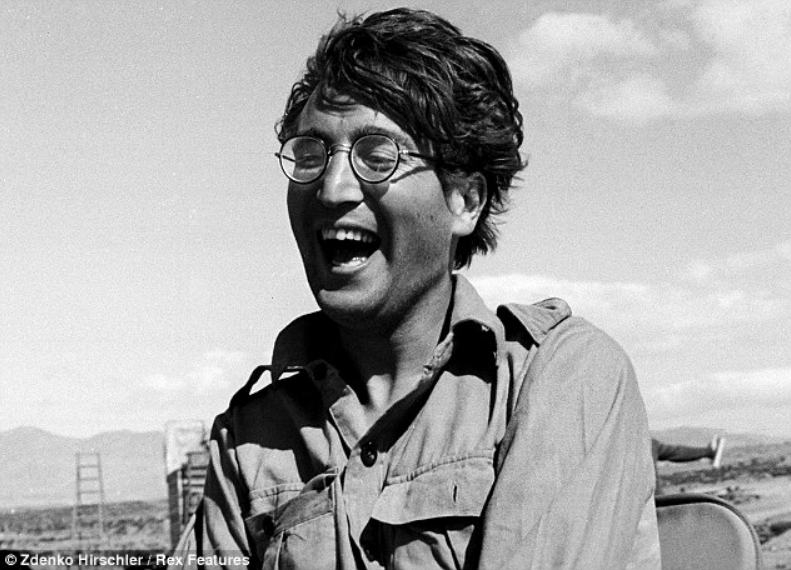 John’s fans may have been surprised to see him wearing glasses in this offbeat little film. Little did they know at the time that his vision had been poor since childhood. His Aunt Mimi constantly nagged him to wear his glasses – which, of course, he hated. Teddy Boys and Gene Vincent wanna-bes didn’t wear glasses! He stumbled around half-blind without specs until he finally began wearing contact lenses during the height of Beatlemania.
John’s fans may have been surprised to see him wearing glasses in this offbeat little film. Little did they know at the time that his vision had been poor since childhood. His Aunt Mimi constantly nagged him to wear his glasses – which, of course, he hated. Teddy Boys and Gene Vincent wanna-bes didn’t wear glasses! He stumbled around half-blind without specs until he finally began wearing contact lenses during the height of Beatlemania.
Imagine his dismay when he learned that his Private Gripweed role called for him to don the owlish wire-framed glasses once issued by Britain’s National Health system. Well, he ended up embracing his new look and wore the specs from that point on – thus creating a signature style that was quickly copied by the youth of the day. Nobody would have been caught dead wearing wire-rimmed granny glasses before John made them fashionable. I remember the day I went from plastic cat-eyes to wire rectangles. Sure, I loathed wearing glasses as a kid, but at least with cool Lennon frames I could feel more like the hippy-dippy flower child I longed to be. And then along came Janis Joplin with those huge round wire specs, to seal the style for chicks. Ah, kaleidoscope eyes behind those lenses.
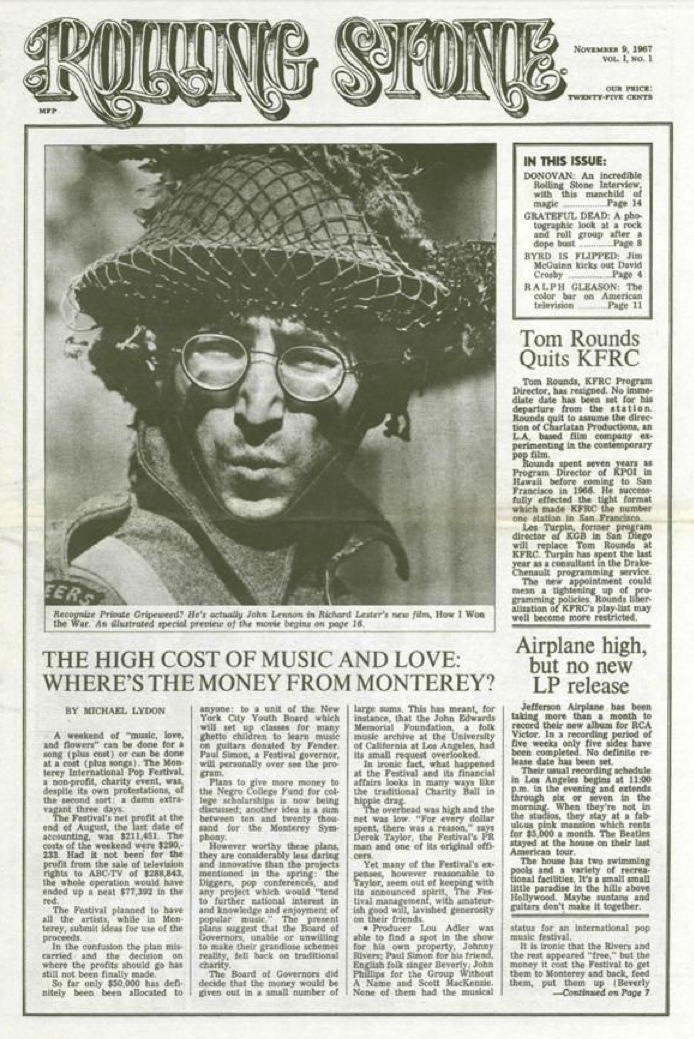 As for the movie? It was a critical and commercial disappointment. And what of John’s acting? Well, inspired, of course…but it really didn’t matter. The project gave him a break from the pressure of touring and recording with the Beatles. But, most importantly, a masterpiece emerged from the experience: during down-time on the set in Almeria, Spain, John composed what I consider his most magnificent song: “Strawberry Fields Forever.”
As for the movie? It was a critical and commercial disappointment. And what of John’s acting? Well, inspired, of course…but it really didn’t matter. The project gave him a break from the pressure of touring and recording with the Beatles. But, most importantly, a masterpiece emerged from the experience: during down-time on the set in Almeria, Spain, John composed what I consider his most magnificent song: “Strawberry Fields Forever.”
An iconic photo of bespectacled John in his combat helmet graced the cover of the very first issue of Rolling Stone magazine, on November 9, 1967 – several weeks after the film’s release.
Here’s a look at John’s scenes in “How I Won the War.”
© Dana Spiardi, October 9, 2014
]]>